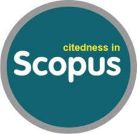SPATIAL SENSE ABILITY INSTRUMENT FOR PRIMARY SCHOOL STUDENTS
Abstract
Keywords
Full Text:
PDFReferences
Alimuddin, H., & Trisnowali, A. (2018). Profil Kemampuan Spasial dalam Menyelesaikan Masalah Geometri Siswa yang Memiliki Kecerdasan Logis. Histogram: Jurnal Pendidikan Matematika, 2 (2): 169-182.
Amalia, L. (2017). Pengembangan Soal Untuk Mengukur Kemampuan Koneksi Antar Topik Matematika Siswa Sekolah Dasar. Jurnal Pendidikan Matematika RAFA, 3(2): 195-206.
Haryati, S. (2012). Research and Development (R&D) sebagai salah satu model penelitian dalam bidang pendidikan. Majalah Ilmiah Dinamika, 37(1):15.
Kusumawardhana, I. N. (2020). Pengembangan Instrumen Pengukuran Kemampuan Spatial Sense (KSS) dan Kemampuan Berpikir Kritis pada Materi Bangun Ruang Siswa Kelas V SD (Doctoral Dissertation, Universitas Pendidikan Ganesha).
Kusumawardhana, I. N., Arnyana, I. B. P., & Dantes, N. (2020). Pengembangan Instrumen Pengukuran Kemampuan Spatial Sense (KSS) dan Kemampuan Berpikir Kritis pada Materi Bangun Ruang Siswa Kelas V SD. Jurnal Penelitian dan Evaluasi Pendidikan Indonesia, 10(1): 51-61.
Nainggolan, E. (2020). Penerapan Pendekatan Concrete-Pictorial-Abstract (CPA) untuk Meningkatkan Sikap Tanggung Jawab, Kemampuan Penguasaan Konsep, dan Kemampuan Pemecahan Masalah Matematika di SDS XYZ Jakarta [Unpublished Doctoral Dissertation]. Universitas Pelita Harapan.
Nechval, N. A., & Nechval, K. N. (2016). Tolerance Limits on Order Statistics in Future Samples Coming from the Two-Parameter Exponential Sistribution. American Journal of Theoretical and Applied Statistics, 5(2-1): 1-6.
Prasetyo, I. (2012). Teknik Analisis Data dalam Research and Development. Jurusan PLS FIP Universitas Negeri Yogyakarta.
Putri, H. E. (2015). Pengaruh Pendekatan Concrete-Pictorial-Abstract (CPA) Terhadap Peningkatan Kemampuan Representasi Matematis, Spatial Sense, dan Self-Efficacy Mahasiswa Calon Guru Sekolah Dasar [Published Doctoral Dissertation] Universitas Pendidikan Indonesia.
Putri, H. E. (2017). Pendekatan Concrete-Pictorial-Abstract (CPA), Kemampuan-Kemampuan Matematis, dan Rancangan Pembelajarannya. Bandung: Royyan Press
Putri, H. E. (2019). Influence of Concrete Pictorial Abstract Approach to the Improvement of Spatial Sense Ability of Elementary School Students. In Journal of Physics: Conference Series, 1157(4): 042083.
Putri, H. E., Isrokatun, I., Majid, N. W. A., & Ridwan, T. (2019, October). Spatial Sense Instrument for Prospective Elementary School Student. In Journal of Physics: Conference Series, 1318(1): 012142.
Putri, H. E., Julianti, R., Adjie, N., & Suryani, N. E. (2017). Pengaruh Pendekatan Concrete-Pictorial-Abstract (CPA) Terhadap Pencapaian Kemampuan Spatial Sense (KSS) Siswa SD. Metodik Didaktik: Jurnal Pendidikan Ke-SD-an, 13(1).
Putri, H. E., Muqodas, I., Wahyudy, M. A., Abdulloh, A., Sasqia, A. S., & Afita, L. A. N. (2020). Kemampuan-kemampuan Matematis dan Pengembangan Instrumennya. UPI Sumedang Press.
Putri, H. E., Rahayu, P., Muqodas, I., & Wahyudy, M. A. (2020, April). The Effect of Concrete-Pictorial-Abstract (CPA) Approach on Improving Elementary School Students' Spatial Sense Ability. In Elementary School Forum (Mimbar Sekolah Dasar), 7(1): 16-29.
Rosdianto, H. (2018). Implementasi Model Pembelajaran Poe (Predict Observe Explain) untuk Meningkatkan Pemahaman Konsep Siswa pada Materi Hukum Newton. http://jurnal.unimed.ac.id/2012/index.php/jpf
Saptini, R. D. (2016). Penerapan Pendekatan Concrete-Pictorial-Abstract untuk Meningkatkan Kemampuan Koneksi Matematis Siswa Sekolah Dasar. [Skripsi Tidak diterbitkan]. Universitas Pendidikan Indonesia
Setiawan, A. R. (2019). Instrumen penilaian untuk pembelajaran ekologi berorientasi literasi saintifik. Assimilation: Indonesian Journal of Biology Education, 2(2): 42-46.
Setiawan, A. R. (2020). Menyusun Instrumen Penilaian untuk Pembelajaran Ekologi Berorientasi Literasi Saintifik. In Prosiding Seminar Nasional dan Workshop Biologi-IPA dan Pembelajaran Ke-4 (SnoWBel IV): 241-249.
Silawati, E. (2021). Interactive Flip Book: Media Pembelajaran Digital untuk Menstimulasi Spatial Sense Anak Usia Dini. In Prosiding Seminar Nasional Unimus (Vol. 4).
Yulia, E. N. R., & Putri, H. E. (2021). Penerapan Pendekatan Concrete-Pictorial-Abstract (CPA) untuk Meningkatkan Spatial Sense Siswa SD. Indonesian Journal of Primary Education, 5(1): 50-62.
DOI: https://doi.org/10.17509/md.v18i1.48632
Refbacks
- There are currently no refbacks.
.png)
Universitas Pendidikan Indonesia, Purwakarta Campus
Jl. Veteran No. 8. Purkawarta
West Java, Indonesia
Email: metodikdidaktik@upi.edu


























